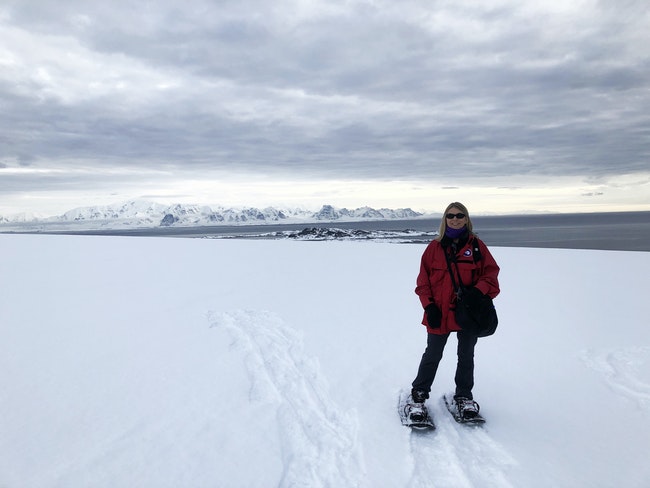
April Waters on Marr Glacier in Antarctica, the landscape that inspired her exhibit of paintings on display at the Hallie Ford Museum of Art (Courtesy/Florence Yates)
A few white knobs huddle below a blue ridge to the far side of a vast landscape of glacial ice, frigid water and sky. Almost unnoticeable, comprising only a tiny fraction of the 6-yard long triptych canvas in oil, “Face of Marr,” they are the buildings of Palmer Station, a scientific research outpost on Anvers Island in Antarctica.
The remote cluster of buildings was Salem artist April Waters’ home for several weeks in 2018 after she was awarded a grant from the National Science Foundation Antarctic Artists and Writers Program. From this obscure outpost, Waters would explore and paint the harsh glacial region and witness the profound changes taking place at the bottom of the earth.
The result is “April Waters: Water-Ice-Sky, Antarctica,” an exhibit of astonishing polar landscapes which shows through August 13 at the Hallie Ford Museum of Art.
The Antarctic, Waters said, “is one of the most stunning places I have ever been, and the huge icebergs are exhilarating to come upon. There is a certain blue green color that occurs in the crevices of the ice, and a blue glow under the surface of an iceberg that is especially radiant.”
Her painting, “Water-Ice-Sky” reflects this acute sense of hue in a brilliant backlit iceberg angled sharply into a large sky streaked with clouds. The water moves relentlessly beneath it and the tall ice wedge is shot through with countless facets, like a luminous blue diamond.
During her time in Antarctica, Waters went out every day to see the frigid landscape, traveling both overland and on several of the boats operated by Palmer Station scientists. She recalled “the sounds of the boat moving through ice, sea birds, the barking of seals and the constant crashes that you hear from the calving of the glacier” as sounds she would not soon forget.
“There were many harshly cold and windy days,” Waters said. “When the sun comes out, it’s spectacular! The vibrant blue of the sky and the sparkling white of the glacier and icebergs take your breath away.”
The experience allowed her “to see and discover something I have never seen or experienced before, and to witness the beauty.”
But Waters didn’t focus on beauty alone. The ice wilderness she shows is also meant to tell the story of climate change. Despite the comparatively small size of Palmer Station – the only sign of human activity in the paintings – an awareness of the arctic’s fragility threads through Waters’ exhibit.
She points to “Pi Island, Antarctica,” a work which documents the receding glacier. She can relate the story of how Pi was “created” in 2014 when warming temperatures finally melted enough ice that Pi separated permanently from the peninsula.
“Learning more about climate change and how it is affecting us locally, globally and especially at the poles certainly informs my work,” Waters said.
Immersed in these scenes from early morning until late at night, and speaking daily with the scientists working there, Waters learned names for the many forms arctic ice can take, including “shuga, frazzle, growlers, brash” she said.
She also shows how frozen things melt. In “Fresh Water Dance,” Waters portrays “sun cups,” rounded divots created by the sun’s heat that speckle the face of a great hunk of floating ice.
This work is a suitable match for the goals of the Hallie Ford Museum of Art at Willamette University, according to John Olbrantz, the Maribeth Collins Director of the museum. “April Waters is an important and supremely talented Salem and regional artist, and displaying her artwork fits beautifully into our mission and focus,” he said.
The result, Olbrantz said, “is spectacular, as it creates a totally immersive experience in the space … the best part of mounting an exhibition like April’s is that we get to work with a local artist who is doing important work and we get to share her work with a broad audience.”
One unexpected challenge for both the artist and museum was to figure out how to retrieve the paintings from Waters’ third floor studio. “We had to lower them via ropes down the side of her house,” Olbrantz recalled.
Even after August, the exhibit’s travels are far from over. In spring 2023 it will be shown at the Giustina Gallery at Oregon State University and in 2024 it will travel to the National Center of Atmospheric Research and the University of Colorado in Boulder. These exhibits will allow many others to share with Waters what she calls, “the thrill and pleasure of experiencing being in the moment with nature.”
A reception will be held in Salem on June 4 for Hallie Ford Museum of Art museum members. The exhibit is on display through August 13. The museum, located at 900 State Street, is open Tuesday through Saturday from noon to 5 p.m. Reserve tickets or get more information on their website.
Writer Helen Caswell can be reached at [email protected].
Story idea? Tip? Contact Salem Reporter by email: [email protected].
JUST THE FACTS, FOR SALEM – We report on your community with care and depth, fairness and accuracy. Get local news that matters to you. Subscribe to Salem Reporter starting at $5 a month. Click I want to subscribe!









